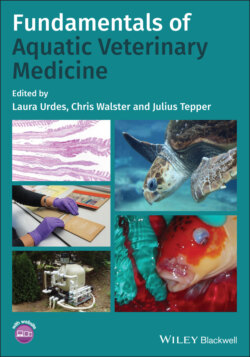Читать книгу Fundamentals of Aquatic Veterinary Medicine - Группа авторов - Страница 44
1.3.3 Biotic Factors of Water 1.3.3.1 Biological Oxygen Demand
ОглавлениеThe biological oxygen demand is a measure of the oxygen used by all organisms in the aquasystem. Microbes (bacteria and fungi) use oxygen to decompose organics (may use 1–3 ppm dissolved oxygen in 24 hours). Phytoplankton respire at night to use oxygen (may use 5–15 ppm dissolved oxygen nightly). Fish respire day and night (may use 2‐6 ppm dissolved oxygen in 24 hours). Dissolved oxygen levels fall at night, since all organisms are respiring, and rise during the day, since plants photosynthesize to use carbon dioxide and eliminate oxygen (may gain 5–20 ppm dissolved oxygen daily). Diffusion and wave/wind action add oxygen (may add 1–5 ppm dissolved oxygen).
The measurement of biological oxygen demand is a chemical procedure which determines the amount of dissolved oxygen needed by aerobic organisms in a body of water to break down organic material present in a given water sample at a certain temperature over a specific time period. It is not a precise quantitative test, although it is widely used as an indication of the organic quality of water. It is most commonly expressed in milligrams of oxygen consumed per liter of sample for five days of incubation at 20°C and is often used as a robust surrogate of the degree of organic pollution of water. Sources of biological oxygen demand include topsoil, leaves and woody debris; animal manure; effluents from pulp and paper mills, wastewater treatment plants, feedlots, and food‐processing plants; failing septic systems; and urban rainwater runoff.
